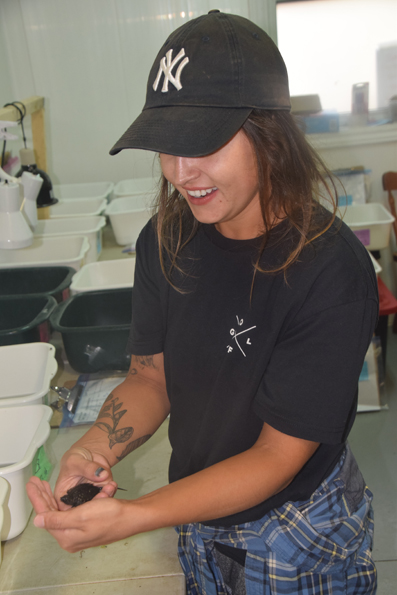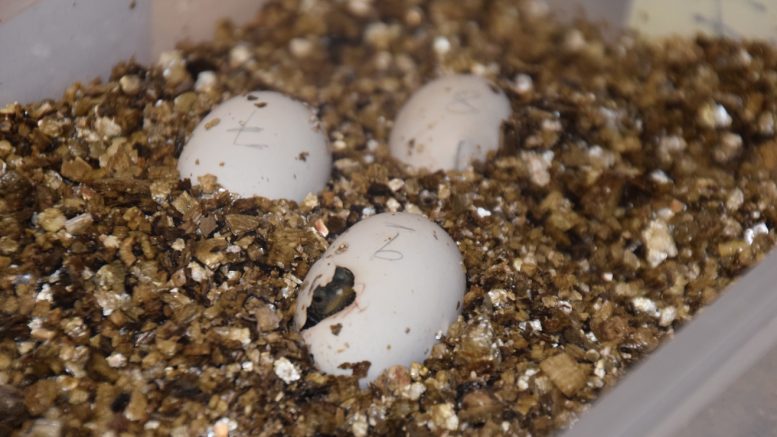Adam Prudhomme
Editor
Sandy Pines Wildlife Centre had a shell of a year, boasting its highest number of incubated turtle hatchlings released to date.
The animal rehabilitation centre in Napanee has turned loose close to 250 baby turtles into the wild, with more still due to be released in the coming weeks.
The eggs have come from five species of turtle-snapping, painted, Blanding’s, northern map and musk-from over 60 different moms. Most were brought to the centre after suffering some form of trauma, such as being struck by a vehicle. Unfortunately in most cases the adult turtle will die after being hit-but many of their eggs can be harvested and then incubated. Other egg clutches have been brought to the centre as a result of damage to a nest-in one instance park staff from Sandbanks Provincial Park brought in a clutch of 44 eggs, 41 of which were successfully hatch in an incubator. Once hatched, volunteers will care for the turtles until they are ready to be released, always back into the same area they were originally found.

New born turtles are cared for until they’re ready to be released back into the wild. Photo by Adam Prudhomme.
“In order to do that we needed extra volunteers,” said Susan Irving, a turtle expert with Sandy Pines. “At the front end our good friends Turtles Kingston put out a Facebook announcement saying we need some help so I trained quite a number of people to do the harvesting of the eggs of the moms that didn’t make it. We had some help caring for the eggs while they were incubated and now we’re caring for the hatchlings until they are released. The extra hands were really essential in us being so successful this year.”
Among those volunteers is Chloe Maracle, who has been busy the last month caring for the hatchings and preparing them to be released. That includes monitoring dozens of buckets that serve as a temporary home for the tiny turtles, some a little bit bigger than a loonie. Maintaining the perfect water temperate is crucial as they develop to the point where they can survive in the wild.

Chloe Maracle is one of the Sandy Pines volunteers who have played a big role in helping the centre have its most successful hatching season to date. Photo by Adam Prudhomme.
“It’s a big job, but it’s worth it and it’s fun because you could just watch them all day long because they’re so cute. You never get tired of just watching them,” said Maracle.
As successful as their egg-hatching program has been this year, it’s not all good news. The fact they’ve had so many eggs means they’ve lost a large number of adult turtles. Though the moms with eggs aren’t a total loss, there are still a high number of males and female turtles with no eggs that have been lost due to injury this year.
“There’s still big concerns with the number of turtles that we’re seeing die on the roadways,” said Irving. “We’re really thrilled with the number that we’ve been able to save.”

A baby turtle swims in its tank, awaiting its release back into the wild. Photo by Adam Prudhomme.
Their work is especially important given the declining number of turtles in general.
“Right now even the snapping turtles are on a list as species of concern. So our work from a conservation point of view is very important,” said Irving.
One of the benefits to hatching in the safe environment of Sandy Pines is that it drastically increases the odds of success. In the wild it’s estimated 1 in 1,000 turtles will reach the age of reproduction.
Another draw back of the successful program is the cost of resources it takes to sustain it. And that’s not just for reptiles, but for all animals they treat at the centre. As word has spread about the centre, more and more patients have continued to arrive from all corners of the province. As a non-profit, they rely on the generosity of the community to help them do the work they do.
To learn more about volunteer opportunities or how to donate, visit https://sandypineswildlife.org/.

